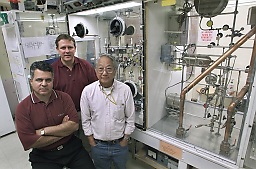| Nucleic acids embrace many more kinds of
molecules than just giant strands of DNA and RNA, and several forms have
shown promise for therapy.
"Nucleic acids and their constituents have been studied for
several years as potential therapeutic agents," says Manouchehr
Saljoughian of Berkeley Lab's National Tritium Labelling Facility (NTLF).
"The most advanced of these are just reaching the clinical trial
stage."
Among the types of nucleic acid with promise for therapy are antisense
agents -- groups of nucleotides that bind to a strand of messenger RNA and
disrupt the passage of genetic information -- and aptamers, sequences of
DNA and RNA that bind to a variety of specific molecules with roles in
controlling gene expression in diseases such as cancer or atherosclerosis
and in other biological functions.
 |

MANOUCHEHR SALJOUGHIAN, PHILIP G. WILLIAMS, AND HIROMI MORIMOTO
IN THEIR LAB
|
Nucleotides are the structural subunits of DNA and RNA molecules,
consisting of sugar-phosphate backbones attached to purine or pyrimidine
bases.
Recently Saljoughian and his NTLF colleagues Hiromi Morimoto and Philip
G. Williams have found a new way of tagging nucleotides for biochemical
studies.
One of the best ways to study how a chemical is distributed and altered
in the body is to label it with a trace amount of a radioactive element.
Tritium is the radioactive isotope of hydrogen, with two neutrons in its
nucleus; since hydrogen is ubiquitous in living tissues, in principle
tritium can be used to label an almost limitless range of biological
molecules.
In practice, the job is not so easy. For example, nucleotides whose
phosphate-backbone segments have been labeled with radioactive phosphorus
are commercially available, but the phosphates in these segments can
separate from the rest of the nucleotide during metabolism. To track each
part of the nucleotide requires additional labeling approaches.
Not only have Saljoughian and his colleagues devised a method for
labeling specific bases, but they can place tritium atoms at particular
positions on the base or independently at positions on the nucleotide's
sugar. An added advantage is that the new phosphorylation technique allows
the nucleotides to be tritiated at a very late step of synthesis --
avoiding the need to work with tritiated compounds at earlier stages.
"The phosphorylation method we use was developed to simplify the
addition of triphosphates to nucleosides in bulk, without having to worry
about unprotected NH and OH groups, which could potentially interfere with
the reaction," says Saljoughian. (A nucleoside is a nucleotide
without the phosphate.)
Saljoughian explains that they have adapted the method to a
"mini-scale" procedure and modified it to synthesize a number of
nucleotides, "including particular precursors of adenosine
triphosphate (ATP) and deoxyadenosine triphosphate (dATP), which we can
subsequently label with tritium."
The process involves successive stages of drying, dissolving, stirring,
adding other reagents and solutions, and drying again -- all in one
"pot" -- until the compound is ready to be analyzed for purity.
Saljoughian and Morimoto have also developed a method of monitoring the
progress of phosphorylation using high-performance liquid chromatography,
particularly useful since the rates of phosphorylation vary greatly
between the various nucleosides, and reaction times have to be adjusted
accordingly.
In the first steps of the ATP or dATP labeling process, a bromine atom
is attached to the base ring where the tritium atom will eventually be
added. After a series of other steps, the triphosphate group is attached,
and in the labeling step the bromine is removed in the presence of tritium
gas and a catalyst, which substitutes tritium atoms at the desired
positions in the molecule. The labeled nucleotide is then enzymatically or
chemically incorporated into the desired DNA or RNA molecule.
As an example of the research being done with tritiated nucleic acids,
Saljoughian cites a collaboration with Scott Taylor of the Lab's Life
Sciences Division to synthesize a sequence of the DNA aptamer for thrombin
-- a factor essential in blood-clotting -- and attach the tritiated dATP
nucleotide to its terminus. Thrombin plays an important role in arterial
disease, and binding a specific, selective nucleic acid to a thrombin
molecule is one way of putting it out of business.
"The system is now being used to test the specificity of the
aptamer for thrombin, as well as the stability of the bound system,"
Saljoughian says.
Saljoughian explains that during the development of a novel labeling
technique, any new procedure is first tested with ordinary hydrogen at a
small scale, and if successful, with deuterium (the nonradioactive isotope
of hydrogen with one neutron), to make sure that hydrogen does not sneak
in from undesired sources. Only then is the process tried with tritium,
using only about 10 percent of the tritium required for a compound with
high specific activity. Only when the process is judged workable and safe
is labeling conducted at full strength.
Part of the National Tritium Labelling Facility's job is to pioneer
techniques too difficult or too capital-intensive for universities and
industry to handle alone.
In addition to the tritiated nucleotides that Saljoughian and his
colleagues have already synthesized, their new method should be useful for
synthesizing many related compounds. The prospect of extending fundamental
research further into the function and uses of nucleic acids powerfully
motivates the efforts of Saljoughian, Morimoto, Williams, Chit Than,
principal investigator David Wemmer, and the users and collaborators of
the NTLF.
Additional Information:
|


